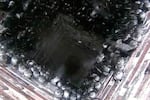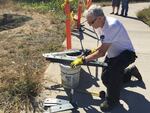
In Albany, Oregon, bird advocates have built a homemade version of the chimneys Vaux's swifts use as a nightly roost.
Cassandra Profita, OPB / EarthFix
Larry Schwitters is putting a lot of hope into a five-gallon bucket of bird poop.
It’s one of the ways he plans to lure thousands of Vaux's swifts into his homemade version of the chimneys these birds use as a nightly roost.
"The idea is we throw it in the chimney and it has an odor supposedly the swifts can smell," he said. "If they fly over it and take a sniff, they’ll think, ‘Hey, swifts have used this before. This is a good one. You can smell it.’”
Vaux’s (rhymes with "boxes") swifts are known for the dazzling displays they create as they funnel into chimneys to roost for the night. But these migratory birds are losing their roosting habitat as old chimneys get demolished. Schwitters and other bird advocates are testing out a replacement they hope the birds will like just as well.

Larry Schwitters empties a five-gallon bucket of swift poop into a new birdhouse he's building to replace a chimney that was recently demolished in Albany, Oregon.
Cassandra Profita, OPB / EarthFix
The swifts have never seen a bird house like this before. Behind him, a 6-foot section of concrete sewer pipe dangles from a crane. Slowly, it’s being lifted onto a vertical stack of pipes coming out of the ground at a public park.
“This is like a tinker toy project," said Jim Fairchild, conservation director for the Audubon Society of Corvallis. "It’s like Legos all over again.”
Fairchild points out the ridges inside the pipes – a special feature they added just for swifts.
"You usually don’t see this in big pipe sections, but here the birds can hang on with their little claws,” he said.
In the natural world, swifts prefer to roost in hollow, old-growth tree trunks. But most of those have been wiped out by logging. So, the swifts have taken to using old chimneys instead. Thousands of them can roost together in the brick and mortar chimneys on old school and hospital buildings. Inside, they cling to the walls and huddle together to stay warm.
But now, their man-made roosts of choice are disappearing, too, thanks in part to a 1940s fire code update requiring concrete liners in chimneys.

Inside old brick chimneys, Vaux's swifts cling to the walls to roost for the night.
Courtesy of Larry Schwitters
"Before World War II, you made your chimneys just out of bricks, and the little birds could hang on the bricks," Schwitters said. "But when they put the smooth concrete liner inside, they've got nothing to hang onto. So the ones they use now are old and crumbly and ready to fall down."
Old chimneys aren’t likely to survive a big earthquake, so many are being torn down. In Albany, the city recently demolished an old firehouse with a chimney where 20,000 swifts were known to roost in the spring.
Schwitters and other bird advocates found a nearby park where they could test out their post-chimney prototype.
"A dedicated Vaux's swift roost made this way has never been done before," Schwitters said. "There's no guarantees this is going to work. It's an experiment. What we think we need to do is get these birds the first migration they come through that they don't have a roost site. That's why we're in a hurry."
Will Wright, a board member with the Audubon Society of Corvallis, saw what happened after a swift chimney was demolished in Ellensburg, Washington.
"It had been a longtime chimney for swifts," he said. "And it was so sad. The next year, the swifts came back and they circled the site for hours.”

Larry Schwitters is the founder of Vaux's Happening, an organization that works to save or replace Vaux's swift habitat.
Cassandra Profita, OPB / EarthFix
Without old chimneys, it’s unclear where the swifts will go to roost. The total number of Vaux’s swifts on the West Coast has been dropping about 2 percent a year. Advocates worry a lack of roost sites may be to blame.
For weeks after the new roost is complete, Audubon volunteers watch the sky at dusk and wait. Through binoculars, Fairchild spots the birds flying around their old roost site – just a few blocks away.
“There are swifts over the old fire station," he said. "They’re starting to gather. They’re going, 'Hey, what’s happening? There’s no roost here.'”

Jim Fairchild watches Vaux's swifts flying near a new birdhouse in Albany.
Nick Fisher / OPB
Even with the birds in sight, the question remains: How do they get the swifts to use their new bird house? They’ve got the bird poop – and one other trick that might bring them in: A recording of swift calls played through a loudspeaker.
Fairchild blasts the sound of chirping birds and waits another 30 minutes or so before calling it quits. So far, the birds have flown by the new roost, but they haven't gone in.
"It's a warm evening," he said. "It's probably not going to get that cold tonight, so they'll be OK."
He’d love to see thousands of birds come to roost here – like they did at the firehouse chimney.

On September evenings, thousands of Vaux's swifts funnel into the chimney at Chapman School in Portland.
Nick Fisher / OPB
“As they somehow collectively decide this is the place to be for the night they start forming into a funnel and then birds will start dropping faster and faster out of the sky," he said. "What triggers that, how they don’t bump into each other – it’s just an amazing phenomenon.”
Fairchild says he’s prepared to wait. The birds migrate South to Central America in the fall and they come back up North in the spring.
"It's a long-term project," he said. "Maybe in a half-dozen years we'll know whether this is working."
If it works, advocates plan to build a whole lot more of these concrete, cylindrical bird houses all along the swifts' migratory route between Canada and Mexico.
"The idea is this will be the first one, and if it works we’re going to have one of these maybe every 100 miles all the way along the migration," Schwitters said. "So, when the chimneys crumble and get torn down, this way the swifts have a place to roost.”
